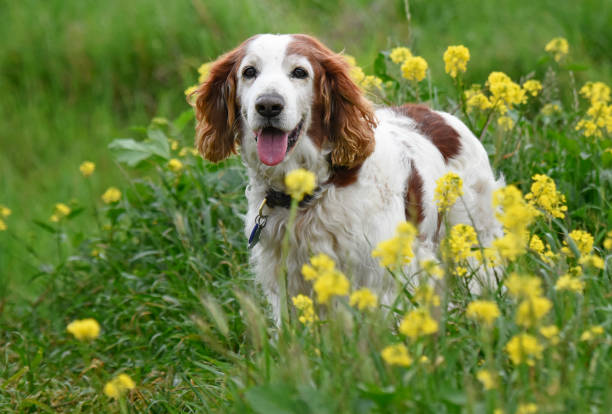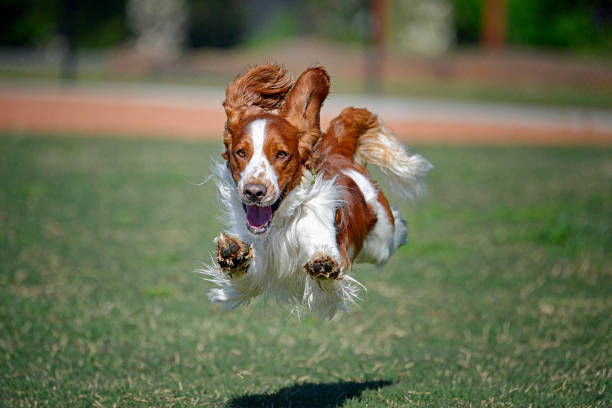Welsh Springer Spaniel

Breed History:
The Welsh Springer Spaniel is an ancient breed believed to have existed in Wales since at least the Middle Ages. It was originally known as the Welsh Spaniel and used to flush game for hunters. By the 18th and 19th centuries, it was recognised as a distinct breed from the English Springer Spaniel, with whom it shares ancestry.
The word “springer” refers to the breed’s method of “springing” game from cover. The Welsh Springer was formally recognised by The Kennel Club in 1902 and the AKC in 1906. Though still relatively rare outside the UK, it is valued for its hunting skills and affectionate temperament.
|
Gender |
Height |
Weight |
|
Male |
46-48 cm |
18-20 kg |
|
Female |
43-46 cm |
16-18 kg |
Size – Medium
Life Expectancy: 12–15 years

Breed Appearance:
The Welsh Springer Spaniel has a compact, muscular build with a slightly rectangular body and a graceful, athletic look. Its head is slightly domed, with a straight muzzle and oval, dark eyes that convey a soft, intelligent expression.
The coat is soft, straight or slightly wavy, and always rich red and white in colour—a defining trait of the breed. Feathers are present on the legs, chest, and ears, and the ears are set low and hang close to the cheeks.
Breed Type – Companion/Gundog:
Bred as a versatile hunting dog, the Welsh Springer Spaniel is known for being loyal, affectionate, and reserved. While devoted to its family, it can be shy or aloof with strangers, more so than its English counterpart.
It makes a wonderful family dog, especially in active households, and gets along well with children and other pets when properly socialised.

Training:
The Welsh Springer is intelligent and eager to work, making it highly trainable with positive reinforcement techniques. It is sensitive by nature, so harsh methods can cause anxiety or resistance.
Early socialisation is essential to prevent excessive shyness. They excel in obedience, agility, rally, and field trials.
Health & Care:
A generally healthy breed, but some conditions to watch for include:
-
Hip dysplasia
-
Epilepsy
-
Eye conditions (entropion, glaucoma)
-
Allergies and ear infections (due to floppy ears)
Health testing and responsible breeding are important. Regular vet care, joint support, and maintaining a healthy weight help ensure long-term health.

Living Conditions:
Welsh Springers are adaptable and can live in houses with yards or large apartments, provided they get enough exercise. They are happiest when close to their people and may develop separation anxiety if left alone for too long.
They are indoor-oriented dogs and prefer being part of daily family activities rather than being isolated.
Exercise:
This breed needs 1–1.5 hours of daily activity, including walks, off-leash play in secure areas, and mentally stimulating games.
Welsh Springers have great stamina and enjoy hiking, swimming, and retrieving. Without enough exercise, they may become bored or destructive.
Grooming:
-
Brush 2–3 times per week to prevent tangles and mats in feathered areas
-
Clean ears weekly to avoid infections
-
Bathe every 4–6 weeks or as needed
-
Routine nail trimming and dental care
They are moderate shedders year-round, with slightly heavier shedding during seasonal changes.

Advantages:
-
Loyal, loving, and great with families
-
Trainable and eager to please
-
Distinctive red-and-white coat
-
Good balance of energy and calmness indoors
-
Excellent companion for active lifestyles
-
Long lifespan with proper care
Disadvantages:
-
Can be reserved with strangers
-
Prone to separation anxiety
-
Requires regular grooming and ear care
-
Needs plenty of exercise and mental engagement
-
Not ideal for sedentary owners
-
It may be hard to find due to its relative rarity

